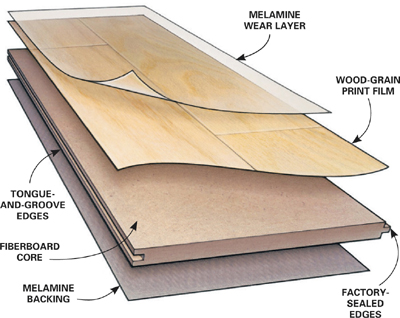
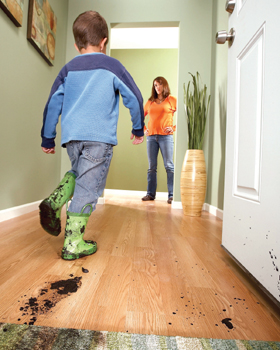
High-quality plastic laminates are ideal for high-traffic areas because they won’t stain, burn, scratch, easily scuff or fade.
Flooring is a big deal. It’s a major expense and a long-term commitment. And few things can make or break your home’s appearance like flooring can. Here’s some expert orientation to put you on a path that will lead to satisfaction rather than regrets.


High-quality plastic laminates are ideal for high-traffic areas because they won’t stain, burn, scratch, easily scuff or fade.
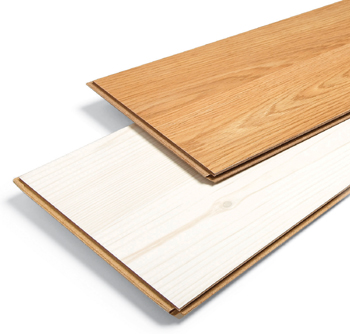
Plastic laminate is one of the toughest floors available; it’s almost impossible to stain and only ceramic tile is more resistant to scratches. It also resists moisture and spills fairly well, so it’s a good choice for basements and kitchens. Plastic laminates vary widely in price and quality. Here’s what you’ll typically get when you pay more:
• BETTER LOOKS: Some laminates are hard to distinguish from real wood. Others are obvious fakes.
• TIGHTER JOINTS: All plastic laminates are floating floors, locked together with tongue-and-groove joints. But some are manufactured to higher standards and lock together more reliably.
• A THICKER, TOUGHER WEAR LAYER: Ask about the AC rating (abrasion class). AC3 floors are best for high-traffic areas. An AC1 floor costs less but will stand up well in a bedroom.
• BETTER MOISTURE RESISTANCE: Better laminates are treated to repel moisture coming from below or between the joints. Cheaper versions will quickly swell or buckle.
Luxury vinyl flooring is similar to sheet vinyl, but it’s thicker, tougher and much easier to install. It’s economical too, with lower materials and labor costs than most other types of flooring.
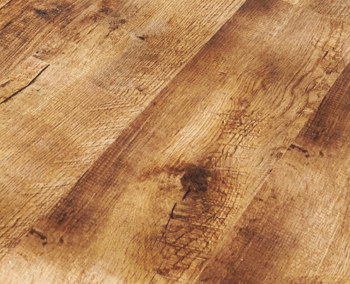
Looks like wood
Luxury vinyl planks (LVP) imitate wood and form a “floating” floor that simply lays on the subfloor without any fastening.
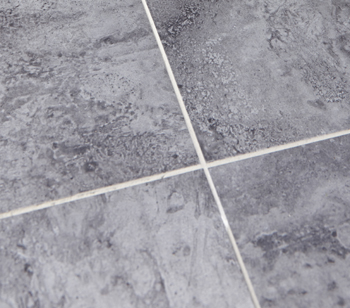
Looks like ceramic tile
Luxury vinyl tile (LVT) can include grouted spaces between tiles—or not. A thin layer of adhesive fastens it to the subfloor.
Voice of experience
Our customers love luxury vinyl because it’s tough and feels good under their feet. We love it because it’s easy to work with.
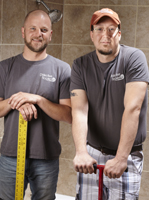
Nate and Andy, flooring pros and The Family Handyman Field Editors
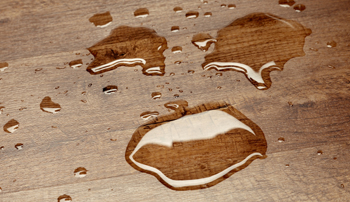
It stands up to water
Luxury vinyl is an excellent choice for laundry rooms, bathrooms and other areas where moisture is a concern. Some manufacturers actually refer to their products as “waterproof” rather than just “water resistant.”
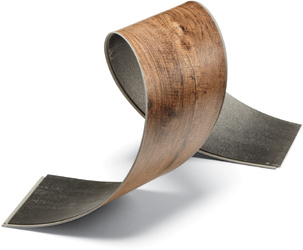
It’s soft and pliable
LVP flooring feels softer and warmer underfoot than most other flooring, which makes it especially nice in bathrooms. It comes in a wide variety of patterns and styles designed to look like wood, granite, tile and other materials. Don’t confuse LV products with the lower-priced (and lower-quality) vinyl composition tile (VCT). LV is made with more solid vinyl, which makes it more durable (and more expensive). LVT can be glued down or installed as a floating floor depending on the type.
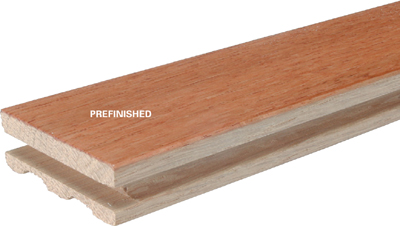
In terms of authenticity and character, the imitators can’t match traditional wood floors. They can’t match the longevity, either. Because solid wood can be sanded and refinished again and again, it often lasts a century or more. Standard solid wood is sanded and finished after installation. Prefinished versions come with a factory finish that’s tougher than on-site finishes. The chief drawbacks of solid wood are durability, stability and cost. Even factory finishes will eventually dull with normal wear. Wood inevitably moves with changes in humidity, so gaps sometimes develop at joints. And solid wood is one of the most expensive flooring choices.
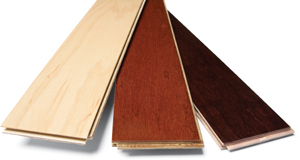
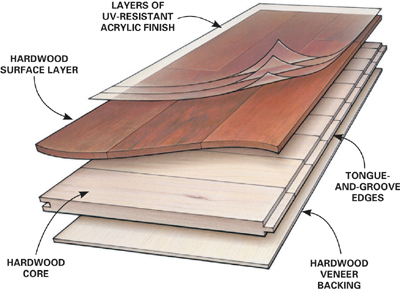
Engineered wood floors are a lot like plastic laminate, but they’re surfaced with real wood. That’s an advantage in terms of natural looks and long-term life span. Once it wears, engineered wood can be refinished to look like new, so an engineered floor can have a much longer life than plastic laminate. Wood is also quieter to walk on than plastic. But engineered wood doesn’t match the surface toughness or moisture resistance of plastic laminate. It also costs about twice as much as plastic laminate.
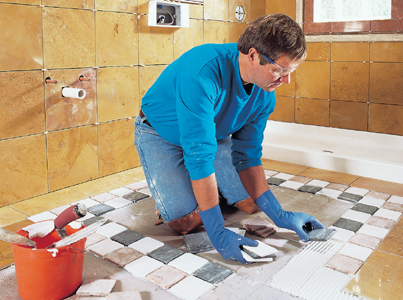
Tile is the most diverse category of flooring. Most versions are extremely durable, but some (like marble or limestone tile) are fairly easy to scratch or stain. Tile can be the most expensive type of flooring, but inexpensive tile combined with DIY installation can give you a low-cost floor that looks great. But there is one thing that applies to all types of tile: Proper installation is critical. Before you hire a contractor, gather some basic knowledge. Familyhandyman.com is a one-stop source for understanding tile backers, adhesives, grout and other keys to an attractive, lasting tile job.
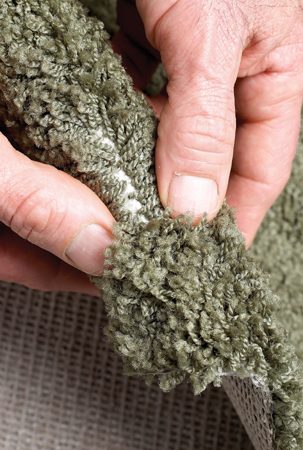
Check the density
Bend the carpet sample backward. If you can see the backing easily, it’s a low-density, lower-quality carpet that will crush more easily.
The right pad will extend the life of your carpet, and the wrong pad can cut the life of your carpet in half. The quality of carpet pad is determined by density, not thickness. A good-quality pad will be 3/8 to 1/2 in. thick and have a density/weight rating of at least 6 lbs. (the residential standard). In most cases, cheap, low-density pad will only last a few years before it needs to be replaced. For high-traffic areas, get a thinner pad with a density of 8 lbs. or more.
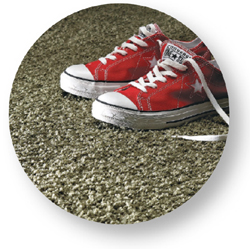
Nylon is tough
Nylon outperforms other fibers in durability, resilience and easy maintenance. It’s a good choice for high-traffic areas like hallways or busy family rooms, and in homes with kids and pets. It costs $10 to $45 per sq. yd.
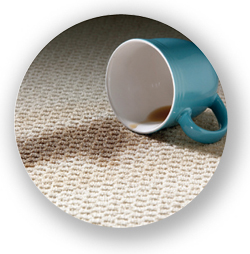
Triexta resists stains
Triexta (brands include Smart-Strand and Sorona) is a newer fiber derived partly from corn sugar. It has excellent, permanent anti-stain properties (nylon must be treated with stain protectors over its life span). It also has good resilience, but it’s too soon to tell whether it will match the long-term durability of nylon in high-traffic areas. Expect to pay $20 to $45 per sq. yd.
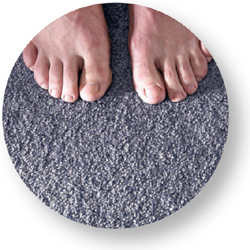
Polyester is comfy
Polyester (also called PET) is stain resistant, very soft and luxurious underfoot, and is available in deep and vibrant colors. However, it’s harder to clean, tends to shed and isn’t as durable as nylon. It’s best used in low-traffic areas (like bedrooms) and in households without kids or pets. It costs $8 to $18 per sq. yd.
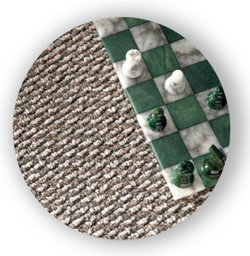
Olefin is economical
Olefin (polypropylene) is inexpensive but tough and fade-resistant. It’s most often made into a looped Berber with a nubby weave that conceals dirt and is often selected for high-traffic “clean” areas such as family rooms and play areas. It costs $8 to $25 per sq. yd.